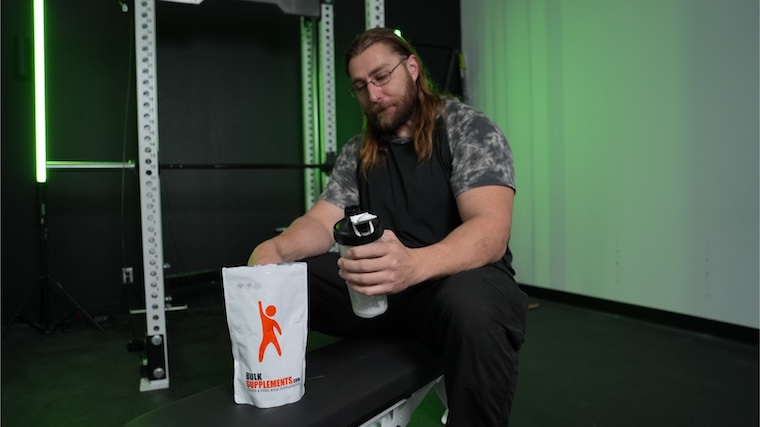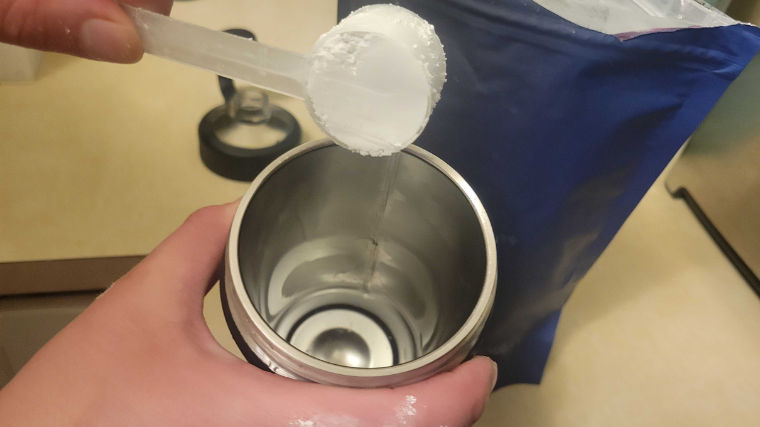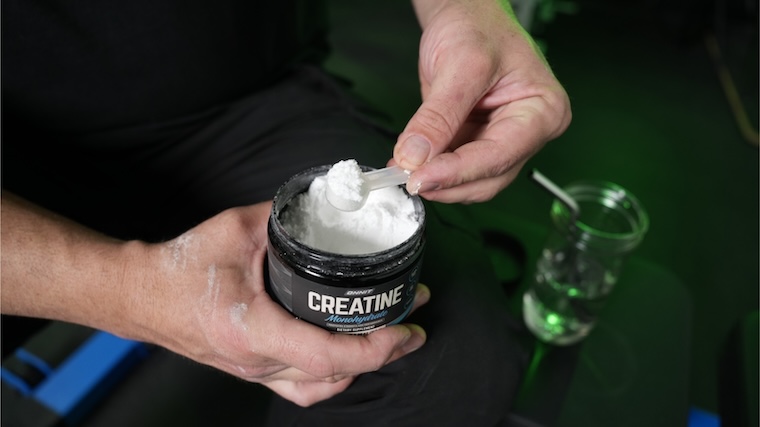The best creatine supplements are among the most effective and scientifically-backed on the market. Bodybuilders use creatine as part of their stacks to bulk up, while strength athletes lean heavily on the supp for its effects on strength gain. Despite its popularity and thorough documentation in the scientific community, there are still a few unanswered questions about creatine and how to best benefit from it. At the center of the conversation is one big question — do you need to “load” your creatine?
Like any nutritional supplement, creatine comes with its own misconceptions and common concerns, ranging from hair loss to digestive issues. Beyond that, there’s the ever-present debate about the merits (or malaise) of a creatine loading phase. Luckily, science can light the way and help you determine if you need to load your creatine to reap the benefits it provides.
Medical disclaimer: The content on BarBend is meant to be informative in nature, but it should not be taken as medical advice. The opinions and articles on this site are not intended for use as diagnosis, prevention, and/or treatment of health problems. It’s always a good idea to talk to your doctor before beginning a new fitness, nutritional, and/or supplement routine. None of these supplements are meant to treat or cure any disease. If you feel you may be deficient in a particular nutrient or nutrients, please seek out a medical professional.
Key Takeaways
- A creatine loading phase is the ramp-up period when you start taking creatine, which requires you to take extra for the first five to seven days before taking the regular dosage.
- A typical dosage during the loading phase is 20 to 25 grams total per day, broken into four or five servings. A a regular dosage outside of loading would be 3 to 5 grams total per day.
- Studies suggest that a loading phase consisting of 20 grams of creatine daily for six days elevated muscular concentrations by 20%, while participants who took the standard dose took 28 days to see those results. (1)
- A creatine loading phase is not necessary, but it can speed up muscle saturation results. (1)
What Is the Creatine Loading Phase?
First, what is creatine? “Creatine is a naturally occurring non-protein amino acid compound primarily found in meat and fish,” says BarBend expert reviewer and registered dietitian Courtney Pelitera. “Creatine’s primary role in the body is to aid in the resynthesis of ATP (from phosphocreatine) to provide energy during muscular contraction.” (2)

Creatine is typically consumed on a daily basis and slowly accumulates in your muscle cells over a period of weeks. However, it is sometimes thought that a “loading phase,” wherein you consume double or triple the amount of a standard 5-gram daily dose of creatine for about a week, can accelerate this process.
Is the Creatine Loading Phase Necessary?
A creatine “loading phase” is exactly what it sounds like. Instead of taking the standard 5-gram dosage per day (whether mixed with one of the best protein powders or ingested on its own), the idea behind loading aims at rapidly accumulating sufficient amounts of creatine in your muscles to aid performance.
How To Do a Creatine Loading Phase
There’s nothing fancy about following a creatine loading phase. It is, quite literally, more of the same. While the science isn’t exactly rock-solid about whether or not a loading phase makes a tangible difference in how you benefit from creatine, there’s not really any harm in it either.
- Over the course of five to seven days, consume 20 to 25 grams of creatine in total, broken up across multiple daily servings. (1)
- Afterward, drop your intake down to the standard 5-gram daily dosage and continue taking it daily.
Alternatively, bulk dosing can be based on your body’s weight, with a loading phase dosage set around 0.3 grams per kilogram of body weight per day and reduced to 0.1 gram per kilogram of body weight per day. (1)
Most literature agrees that loading your creatine in bulk isn’t strictly necessary for it to take effect long-term. That said, it could be useful in certain conditions, such as if your baseline creatine levels are extremely low, or you take too little on a daily basis. (1)
[Related: Best Creatine For Men]
Exceptions to the “Rule”
If you’re in a hurry to maximize your stores, a loading phase of 20 grams per day has been shown to elevate muscular concentrations by 20% in just six days. It could take as long as 28 days to achieve this while using a a 3- to 5-gram daily dose. (1)

If you’re using less than 5 grams of creatine per day, a loading phase might be necessary for you to see improvements in upper-body strength. When it comes to lower-body strength improvements, you might need a combination of both a loading phase and doses higher than 5 grams per day.
Interestingly, some evidence suggests that it’s better to calculate your required dose based on your body’s weight rather than relying on the “standard” 5-gram dosage. (3)
How Does Creatine Work?
Each skeletal muscle cell is filled with proteins that attach and pull on each other to create muscular contractions, like a longboat full of rowers paddling along. Between each turn of the oar, some of these proteins need to be reset to their original position, which requires adenosine triphosphate, or ATP — the “energy currency” of your muscle cells. (2)

ATP can be produced through different channels, but the phosphocreatine (PCr) system is the fastest way to replenish ATP during times of extremely high-energy demands. Supplementing creatine expedites this process, in the way that putting the right type of gas in your car helps it run more efficiently.
While your body does produce scant amounts of creatine to speed this all along, there are a number of foods with creatine you can work into your diet. (3)(4) “Creatine is… found naturally in animal proteins such as meat and fish,” says Courtney Pelitera, BarBend expert reviewer and a registered dietitian. “Foods such as beef, pork, herring, tuna, and salmon are great examples of naturally occurring creatine.”
There are also, of course, supplements. Creatine monohydrate is the most effective supplemental form due to its high bioavailability. (1)
Benefits of a Creatine Loading Phase
Creatine does much more than simply delivering phosphate groups and shuttling various metabolites around. “Creatine is a supplement that has solid research to support muscle growth, among other positive health benefits,” says BarBend expert reviewer Dr. Kimberly Langdon, M.D. Read more about creatine’s benefits below.
- Creatine can enhance muscle contractions by increasing calcium concentrations in the muscle cell, a bit like adding more rowers to a boat.
- It can also support muscle growth and reduce muscle protein breakdown by modifying both protein synthesis, inflammation, and oxidative stress.
- Another benefit is its potential to provide another source of energy during exercise and enhance glycogen storage post-workout.
- It may also improve power output, increase the number of reps you can pump out before reaching failure, and even make you faster on the field or court.
All of which translates, in real-world terms, to better athletic performance, more exercise volume in the gym, and potentially greater gains. (3)(4)(5)(6)(7)
Another potential benefit, research suggests, is a positive impact on brain health. (10) “Besides helping the muscles to heal faster after strenuous workouts, some studies show that cognitive function may be improved especially as it pertains to depression,” adds Dr. Langdon.
Side Effects of Creatine
Even the most thoroughly-research supplement on the market is prone to misinformation. The rumor mill churns day and night, and poorly-sourced claims or baseless allegations may negatively impact your perception of a perfectly innocuous supplement like creatine.
“Taking creatine as a supplement has very little known side effects,” says BarBend expert reviewer and registered dietitian Courtney Pelitera. “While the most well-documented potential side effects include gastrointestinal upset, muscle cramps, and an increase in overall body weight (due to increased fluid in the muscle cells), most of these are not heavily reported in clinical trials.”
Let’s talk about some alleged creatine side effects and a few other sources of confusion regarding the supplement.
- No studies have actually reported hair loss or baldness as a direct result of creatine supplementation. (1)
- Creatine might lead to higher water retention in muscle cells, but there’s no evidence that it causes water retention elsewhere, so it’s unlikely to lead to abdominal water retention and stomach bloating. (1)(6)
- Creatine can lead to some weight gain initially as a result of your muscles holding more water. The initial weight gain from creatine does correlate with improvements in power output, though. (1)(4)(6)
- Contrary to popular belief, there are no clear advantages to taking creatine at any specific time, whether it be prior to, during, or after a workout. Caffeine intake might reduce the ergogenic effects of creatine, (8) so if you caffeinate before you hit the gym, it might be best to take your creatine after your workout.
- Taking creatine about two hours before your workout could potentially enhance its uptake rate. However, the results are far more similar than they are different regardless of timing, so it’s probably best to simply take your creatine at whatever time is convenient and consistent. (4)(8)
The Case for a Creatine Loading Phase
When it comes to the many benefits of creatine supplementation, the science is solid. When it comes to loading phases, timing, hair loss, bloating, and weight gain, there’s unfortunately more science fiction out there than science fact.

While a loading phase can be useful in some situations, it isn’t necessary, and could cause gastrointestinal distress if done improperly. Fortunately, maintenance doses aren’t associated with unpleasant side effects, and no dosing protocol has been credibly linked to hair loss. Whether you choose to front-load your creatine or take it as prescribed, you’re going to reap the benefits in the gym either way.
FAQs: Creatine Loading Phase
How do you load creatine?
After buying a tub of creatine (or some of the best creatine gummies), consume 20 grams of creatine daily for five to seven days. (We recommend spacing it out throughout the day to avoid any GI issues.) After those five to seven days, scale down your creatine dosage to 3 to 5 grams per day. This dosage is backed by numerous scientific studies. (1)
Can I skip creatine loading phase?
You sure can — and you probably should if you have a sensitive stomach (and a little bit of patience). Research suggests that you will see the same results if you stick to a daily dose of 3 to 5 grams of creatine per day. The difference is that it will take roughly four weeks to reach the skeletal muscle saturation levels you would see after a six-day creatine loading phase. (1)
What is a good loading phase for creatine?
Several studies suggest that a safe, effective creatine loading phase consists of 20 grams of creatine daily for six days. (1)
Can I take 20 grams of creatine at once?
Athletes should spread out their creatine consumption during a loading phase, as dosages greater than 10 grams can potentially lead to GI distress. (9) It’s recommended that those in a loading phase opt for a schedule that includes 5-gram dosages at four different times during the day. Beyond the initial loading phase of five to seven days, however, creatine consumption should be limited to the clinically-backed daily dose of 3 to 5 grams.
Do I need to load creatine?
No. Studies suggest that those who skip the loading phase and take the clinically-backed dose of 3 to 5 grams of creatine per day will see the same results as those who load. That said, it will take longer for the creatine to saturate the skeletal muscle tissue and support your strength-training goals. According to research, it will take roughly four weeks of taking a 3- to 5-gram dose of creatine to reach the saturation levels of a six-day loading phase. (1)
When should you restart creatine loading phase?
If you’re currently in the maintenance phase of your creatine supplementation, there’s no need to restart a creatine loading phase. Though there’s minimal research speaking to its benefits, some athletes recommend “creatine cycling,” which can consist of a one-week loading phase, a two-month maintenance phase, and a three-week break before restarting the cycle.
References
- Antonio, J., Candow, D. G., Forbes, S. C., Gualano, B., Jagim, A. R., Kreider, R. B., Rawson, E. S., Smith-Ryan, A. E., VanDusseldorp, T. A., Willoughby, D. S., & Ziegenfuss, T. N. (2021). Common questions and misconceptions about creatine supplementation: what does the scientific evidence really show? Journal of the International Society of Sports Nutrition, 18(1), 1–17.
- Dunn J, Grider MH. Physiology, Adenosine Triphosphate. [Updated 2023 Feb 13]. In: StatPearls [Internet]. Treasure Island (FL): StatPearls Publishing.
- Forbes, S. C., Candow, D. G., Ostojic, S. M., Roberts, M. D., & Chilibeck, P. D. (2021). Meta-analysis examining the importance of creatine ingestion strategies on lean tissue mass and strength in older adults. Nutrients, 13(6), 1–14.
- Mills, S., Candow, D. G., Forbes, S. C., Neary, J. P., Ormsbee, M. J., & Antonio, J. (2020). Effects of creatine supplementation during resistance training sessions in physically active young adults. Nutrients, 12(6), 1–11.
- Feurebacher, J., & Schumann, M. (2021). Short-Term Creatine Loading Improves Total Work and. Nutrients, 13.
- Bogdanis, G. C., Nevill, M. E., Aphamis, G., Stavrinou, P. S., Jenkins, D. G., Giannaki, C. D., Lakomy, H. K. A., & Williams, C. (2022). Effects of Oral Creatine Supplementation on Power Output during Repeated Treadmill Sprinting. Nutrients, 14(6), 1–14.
- Doma, K., Ramachandran, A. K., Boullosa, D., & Connor, J. (2022). The Paradoxical Effect of Creatine Monohydrate on Muscle Damage Markers: A Systematic Review and Meta-Analysis. Sports Medicine, 52(7), 1623–1645.
- Candow, D. G., Forbes, S. C., Roberts, M. D., Roy, B. D., Antonio, J., Smith-Ryan, A. E., Rawson, E. S., Gualano, B., & Roschel, H. (2022). Creatine O’Clock: Does Timing of Ingestion Really Influence Muscle Mass and Performance? Frontiers in Sports and Active Living, 4(May), 1–8.
- 105. Ostojic SM, Ahmetovic Z. (2008). Gastrointestinal distress after creatine supplementation in athletes: are side effects dose dependent? Res. Sports Med, 16:15–22.
- Roschel, H., Gualano, B., Ostojic, S. M., & Rawson, E. S. (2021). Creatine supplementation and Brain Health. Nutrients, 13(2), 586.